Physical Address
304 North Cardinal St.
Dorchester Center, MA 02124
Probably the most common problems in the diagnosis of pancreatic neoplasms are the distinction of invasive ductal adenocarcinoma from its mimics and the preoperative evaluation of cystic lesions, which are increasingly recognized. Solid, cellular pancreatic neoplasms present a different type of diagnostic challenge. The relative inaccessibility of the pancreas and the potential for complications from biopsies mean that small tissue samples (core biopsy or fine-needle aspiration [FNA] biopsy) are commonly the only specimens available for diagnosis, and for many patients, it is a biopsy of metastatic disease that is the basis for the diagnosis. This has become even more crucial with neoadjuvant therapy being more widely employed. Recent work has helped clarify the diagnostic features of cystic and intraductal neoplasms, neuroendocrine neoplasms, acinar cell neoplasms and related entities, as well as rare variants of ductal adenocarcinoma. A range of ancillary diagnostic tools are available to aid in accurate diagnosis, and correlation with clinical and radiographic findings is also helpful.
Through increased use of sensitive imaging techniques, such as spiral CT scanning, endoscopic ultrasound, magnetic resonance cholangiopancreatography (MRCP), and functional imaging, there has been an increase in detection of less common types of pancreatic tumors. In addition, advances in surgical techniques and improvements in postoperative care have rendered pancreatectomy a relatively commonplace operation, with markedly decreased mortality and morbidity. The past few decades have witnessed the characterization of several previously unrecognized types of pancreatic neoplasms and tumor-like lesions (such as autoimmune pancreatitis). The classification of pancreatic neoplasms and the delineation of the mechanisms of pancreatic neoplasia also have changed somewhat with the publication of the new World Health Organization classification in 2019. In the following sections, the pathology of pancreatic neoplasms and tumor-like lesions is presented.
The current classification of pancreatic neoplasms is outlined in Box 41.1 . , The classification system is based on three general features: (1) the line(s) of cellular differentiation reflected in the neoplasm, (2) the gross configuration of the tumor (solid vs. cystic vs. intraductal), and, for the subgroup of potentially noninvasive neoplasms, (3) the degree of dysplasia (low- or high-grade).
Tubular (conventional) adenocarcinoma
Colloid (mucinous noncystic) carcinoma
Medullary carcinoma
Adenosquamous carcinoma
Signet ring cell carcinoma
Hepatoid carcinoma
Undifferentiated carcinoma
Anaplastic (giant cell) carcinoma
Sarcomatoid carcinoma
Carcinosarcoma
Undifferentiated carcinoma with osteoclast-like giant cells
Mixed ductal-neuroendocrine carcinoma
Low-grade PanIN
High-grade PanIN
Intraductal papillary-mucinous neoplasms
Intraductal papillary-mucinous neoplasm with low-grade dysplasia
Intraductal papillary-mucinous neoplasm with high-grade dysplasia (carcinoma in situ)
Intraductal papillary mucinous neoplasm with an associated invasive carcinoma
Intraductal oncocytic papillary neoplasms
Intraductal oncocytic papillary neoplasm
Intraductal oncocytic papillary neoplasm with an associated invasive carcinoma
Intraductal tubulopapillary neoplasms
Intraductal tubulopapillary neoplasm
Intraductal tubulopapillary neoplasm with an associated invasive carcinoma
Microcystic serous cystadenoma
Macrocystic serous cystadenoma
Solid serous adenoma
Serous cystadenocarcinoma
Mucinous cystic neoplasm with low-grade dysplasia (mucinous cystadenoma)
Mucinous cystic neoplasm with high-grade dysplasia (carcinoma in situ)
Mucinous cystic neoplasm with an associated invasive carcinoma
Acinar cell carcinoma
Cystic and intraductal acinar cell carcinomas
Cystic acinar transformation
Mixed acinar-neuroendocrine carcinoma
Mixed acinar-ductal carcinoma
Mixed acinar-neuroendocrine-ductal carcinoma
Neuroendocrine microtumor
Well-differentiated pancreatic neuroendocrine tumor
Functional
Insulinoma
Glucagonoma
Somatostatinoma
VIPoma
Nonfunctional
PPoma
Not otherwise specified
Poorly differentiated neuroendocrine carcinoma
Small cell carcinoma
Large cell neuroendocrine carcinoma
Lymphoma
Secondary neoplasms
The line of differentiation refers to the cellular phenotype of the neoplasm. Most pancreatic tumors recapitulate one or more of the normal epithelial cell lines of the pancreas: ductal, acinar, or neuroendocrine ( Fig. 41.1 ). The defining pathological features of each of these cell types are reflected, to various degrees, in their corresponding neoplasms ( Table 41.1 ).
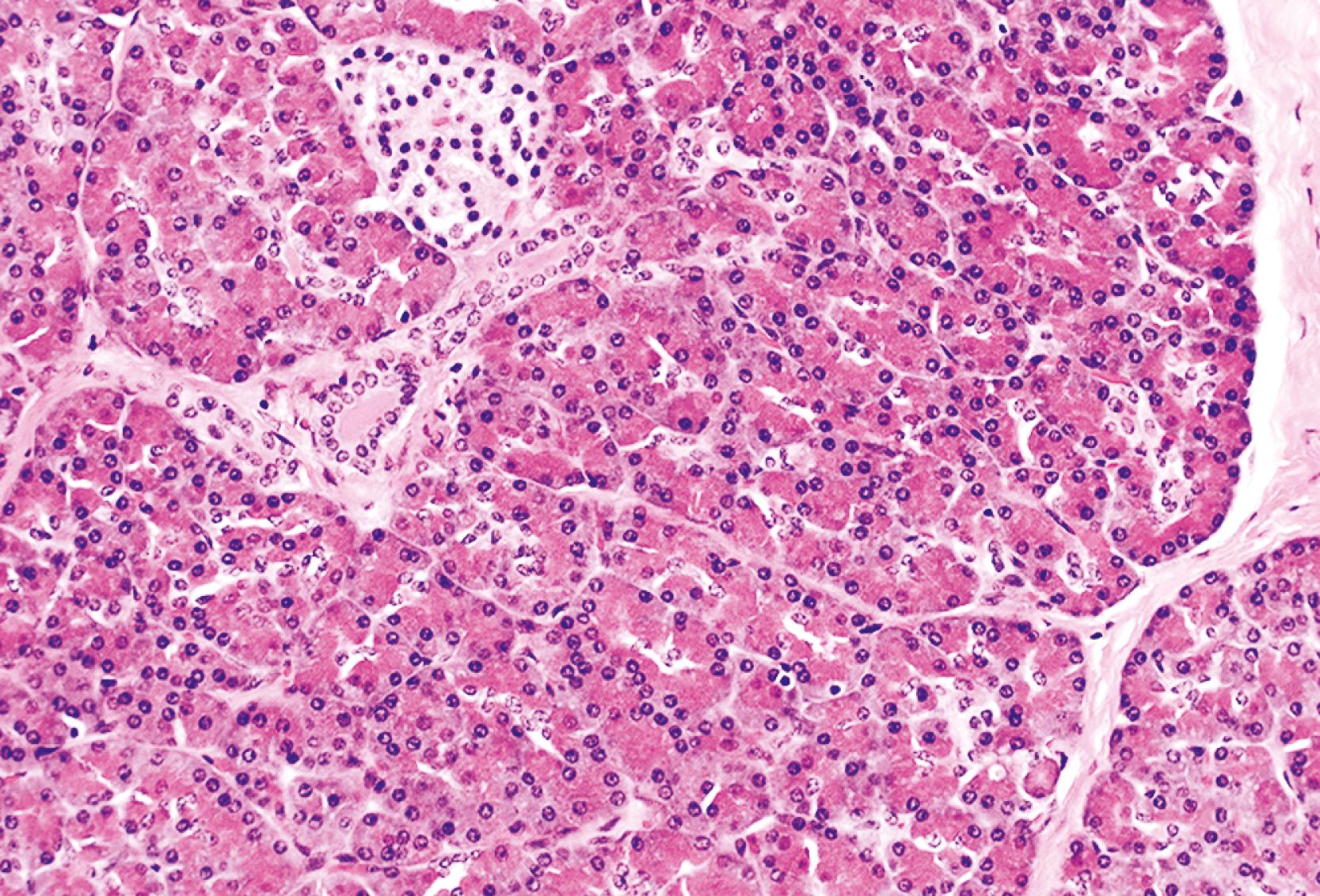
| Cell Line | Light Microscopy | Histochemistry | Immunohistochemistry | Ultrastructure | Genetic Changes |
|---|---|---|---|---|---|
| Ductal | Glands, papillae, lumina, mucin | Mucin stains positive | Glycoprotein markers (B72.3, CEA, DUPAN2, MUC1, CA19-9) | Mucigen granules | KRAS, TP53, DPC4, p16 |
| Acinar | Solid sheets, nests, acini; granular eosinophilic cytoplasm; prominent nucleoli | d-PAS positive granules | Enzyme markers (trypsin, chymotrypsin, lipase) | Zymogen granules, irregular fibrillary granules | APC/β-catenin pathway |
| Neuroendocrine | Nested, trabecular, gyriform patterns; cytological uniformity; salt-and-pepper chromatin | Argyrophil (Grimelius)-positive granules | Neuroendocrine markers (chromogranin, synaptophysin) | Neurosecretory granules | MEN1 gene, DAXX/ATRX genes, mTOR pathway genes |
Ductal differentiation in pancreatic neoplasms is defined as recapitulation of the characteristics of normal ducts, that is, gland or tubule formation and mucin production. Mucin can be demonstrated histochemically with stains such as periodic acid–Schiff (PAS), mucicarmine, or high iron diamine and Alcian blue, and it is regarded as a hallmark of ductal differentiation in the pancreas, although it is not invariably present in neoplasms of ductal type. Immunohistochemical markers of ductal differentiation such as CA19-9, carcino-embryonic antigen (CEA), B72.3, DUPAN-2, and MUC1, many of which detect mucin-related antigens or oncoproteins, are often helpful. In addition, mutations at codon 12 of the KRAS oncogene are common (>90%) in ductal adenocarcinomas and are also present in many related carcinomas and preinvasive neoplasms of ductal type. Because KRAS mutations are not usually present in nonductal neoplasms, they may also be considered as evidence of ductal differentiation in certain situations. Expression of specific keratin subtypes, including cytokeratins 7 and 19 (CK7 and CK19), is characteristic of ductal neoplasms, but not lineage specific.
Neuroendocrine differentiation is defined as the production of peptide hormones or bioamines by tumor cells. In addition, well-differentiated pancreatic neuroendocrine tumors (PanNETs) often have an organoid growth pattern and a characteristic appearance of the nuclear chromatin. Neuroendocrine differentiation is documented mainly by immunohistochemistry. The general neuroendocrine markers, chromogranin A and synaptophysin, are considered most specific. Other neuroendocrine markers include neuron-specific enolase (NSE), Leu7 (CD57), and neural cell adhesion molecule (CD56), but the specificity of these has been questioned, and they are no longer recommended for the diagnostic confirmation of neuroendocrine differentiation. A novel marker, insulinoma-associated protein 1 (INSM1), is still being assessed but appears to be quite specific. The production of specific peptides or bioamines may also be demonstrable in certain PanNETs, but it is not necessary diagnostically. Electron microscopy may be used to identify dense core secretory granules, but this technique has been largely supplanted by immunohistochemistry.
Despite the preponderance of acinar cells among the epithelial elements of the pancreas, pancreatic neoplasms with acinar differentiation are uncommon. In addition to having characteristic light microscopic features, acinar cell neoplasms produce zymogen granules containing pancreatic enzymes that can be detected by immunohistochemistry. Antibodies directed against trypsin and chymotrypsin are the most widely used, and lipase, elastase, and a few others can also be detected. The antibody BCL10 cross-reacts with carboxyl ester hydrolase and therefore also detects lipase and can verify acinar differentiation. Zymogen granules can be demonstrated with PAS stain, which shows resistance to diastase (d-PAS) and typically reveals small, positive cytoplasmic granules. Zymogen granules can be visualized ultrastructurally as well. A second granule type, termed irregular fibrillary granule, is considered a highly specific ultrastructural feature of acinar cell neoplasms.
Many primary tumors of the pancreas have a characteristic radiographic and gross appearance. Thus most can be divided into primarily solid or primarily cystic categories ( Table 41.2 ). Several types of tumors are inherently cystic, with each locule lined by neoplastic epithelial cells. Others develop cystic change through a process of degeneration, necrosis, or both; this feature is characteristic of some entities, but it may occur in typically solid tumor types as well. Finally, intraductal tumors often appear cystic because of the presence of dilation of the native pancreatic ducts.
| Typically Solid Neoplasms | Typically Cystic Neoplasms |
|---|---|
| Ductal adenocarcinomas (and variants) | Serous cystic neoplasms |
| Pancreatic endocrine neoplasms | Mucinous cystic neoplasms |
| Acinar cell carcinomas | Intraductal papillary mucinous neoplasms |
| Pancreatoblastomas | Solid pseudopapillary neoplasms |
| Lymphoepithelial cysts |
The ductal system of the pancreas, which is responsible for carrying acinar secretions to the duodenum, is not the most abundant epithelial component of the organ. However, most pancreatic neoplasms (>90%) are of ductal origin, and most of these (80% to 90%) are invasive ductal adenocarcinomas. In general, the term pancreas cancer is used synonymously with ductal adenocarcinoma, despite the fact that there are many other carcinoma types that arise within this organ. It is this type of neoplasm that imbues pancreatic cancer with such a dismal outlook. The diagnosis of ductal adenocarcinoma remains problematic for pathologists.
Pancreatic carcinomas of ductal type are separated into the following three general categories:
Conventional ductal adenocarcinoma, which consists of small, tubular glands with luminal and intracellular mucin, associated with marked stromal desmoplasia.
Unusual histological variants of conventional ductal adenocarcinoma, such as foamy gland pattern, large duct pattern, vacuolated pattern, and lobular carcinoma-like pattern.
Other carcinomas of ductal origin, such as colloid carcinoma, adenosquamous carcinoma, squamous cell carcinoma, medullary carcinoma, hepatoid carcinoma, and undifferentiated carcinomas. Carcinomas in this last category often have an associated conventional ductal adenocarcinoma component, which provides evidence of their ductal origin.
This is the most common type of pancreatic neoplasm and is one of the most lethal of all human cancers. According to the American Cancer Society, it is estimated that there will be 60,430 new cases and 48,220 deaths in the United States in 2021, and the number of new cases appears to have risen significantly over the past few decades. The age-adjusted incidence rate is 11 per 100,000 individuals. Pancreatic cancer is the third leading cause of death from cancer in the United States and accounts for 7% of cancer deaths. Affected patients are usually between 60 and 80 years of age; occurrence in patients younger than 40 years of age is unusual. Patients usually present with jaundice (caused by invasion and obstruction of the common bile duct) when the carcinoma is in the head of the pancreas, or they present with nonspecific symptoms such as back pain and weight loss. The cause of ductal adenocarcinoma is complex and probably multifactorial. Smoking and high intake of dietary fat are considered risk factors. Whether acquired chronic pancreatitis and diabetes mellitus constitute risk factors is a subject of ongoing debate, although patients with hereditary chronic pancreatitis and tropical calcifying pancreatitis are considered at increased risk. Although most ductal adenocarcinomas are sporadic, pancreatic cancer is familial in about 10% of cases. The genetic basis for most (80%) familial cases is unknown, but heritable genetic syndromes that increase the risk of pancreas cancer are known, such as hereditary breast cancer syndrome (resulting from BRCA2 or, less commonly, BRCA1 mutations), FAMMM (familial atypical multiple-mole melanoma) syndrome (resulting from CDKN2A mutations), Peutz-Jeghers syndrome (resulting from STK11/LKB1 mutations), familial pancreatitis (resulting from PRSS1 mutations), hereditary nonpolyposis colorectal cancer (HNPCC) syndrome (resulting from mutations in DNA mismatch repair genes), and Fanconi’s anemia (resulting from FANC-C and FANC-G mutations). Some families also carry germline mutations in PALB2 and ATM . Patients with familial pancreatic carcinoma also appear to develop intraductal papillary mucinous neoplasms (IPMNs) at an increased frequency. , Recently, an anatomic variation normally seen in 10% of the population, low union, in which the cystic duct adjoins the common bile duct in the intrapancreatic location or immediately above the pancreas border, has been detected in 42% of ordinary ductal adenocarcinomas of the head and 73% of distal common bile duct (CBD) cancers. This, combined with the fact that most pancreatic adenocarcinomas occur in the head, has led to the speculation that change in flow pattern and chemical composition of bile may be a factor in the ductal carcinogenesis. It is believed this may also be linked to the other peculiar risk factors identified in epidemiological studies such as history of cholecystectomy, peptic ulcer disease, and periodontal conditions.
Most ductal adenocarcinomas (>75%) are solid tumors, and 60% to 70% develop in the head of the pancreas. Possibly because of the lack of a capsule surrounding the pancreas, ductal adenocarcinomas typically involve surrounding structures, especially the common bile duct, duodenum, and peripancreatic soft tissues, early in the course of the disease, when the tumors are relatively small. Ductal adenocarcinomas that develop in the tail of the pancreas may spread to surrounding organs (spleen, kidney, stomach, and colon). In fact, if a solid pancreatic tumor measures larger than 5 cm and is still resectable, it is unlikely to represent a ductal adenocarcinoma. Most cases (close to 80%) are unresectable at the time of diagnosis, largely because of encasement of major mesenteric vessels or metastases to the liver, peritoneum, or other sites. Many ductal adenocarcinomas disseminate very early in the course of disease, although some data suggest that the subset of cases lacking mutations in Smad4 ( DPC4 ) remains more localized to the pancreas and adjacent structures.
Grossly, most ductal adenocarcinomas are solid, firm, infiltrative tumors ( Fig. 41.2 ) with ill-defined borders. The cut surface is often gritty or slightly gelatinous. , Less commonly, gross areas of necrosis may be present. It is often difficult to distinguish a carcinoma from adjacent areas of fibrosing chronic pancreatitis, which commonly coexists. For tumors in the head of the gland, direct invasion of the common bile duct and duodenum is common. The major pancreatic ducts coursing through the carcinoma are usually narrowed or even completely obliterated. Recognition that the center of the tumor is grossly located within the head of the pancreas is helpful in distinguishing pancreatic ductal adenocarcinomas (PDACs) from primary carcinomas of the common bile duct, duodenum, or ampulla of Vater. Some ductal adenocarcinomas exhibit cystic change, either from necrosis with cystic degeneration, as a result of cystic dilation of obstructed ducts (retention cyst formation), or because of cystic dilation of the neoplastic glands themselves (large duct pattern; see later discussion). In some cases, invasive ductal adenocarcinomas may be associated with a preexisting noninvasive cystic or intraductal neoplasm, such as a mucinous cystic neoplasm (MCN) or an intraductal papillary mucinous neoplasm. Some ductal adenocarcinomas have central necrosis and form a more demarcated tumor similar to centrally necrotizing/hyalinizing carcinomas described in the breast, and this seems to be more commonly associated with high-grade carcinomas showing metaplastic changes including sarcomatoid and squamoid.
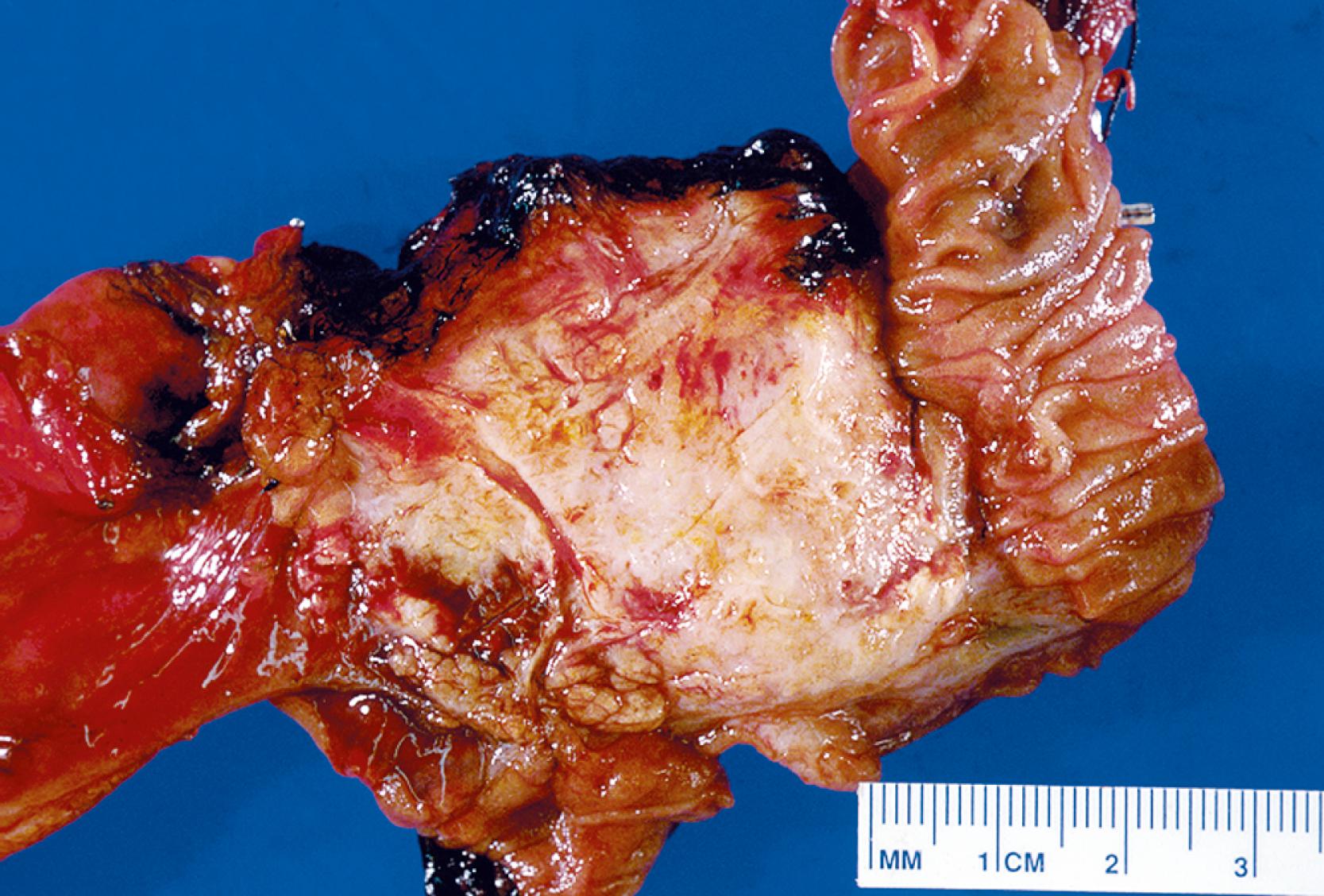
Microscopically, in its conventional form, ductal adenocarcinoma is characterized by small tubular structures lined by cuboidal mucinous cells associated with abundant desmoplastic stroma ( Fig. 41.3 ). In well-differentiated ductal adenocarcinomas, the growth pattern and cytological appearance of the cells may be deceptively benign, closely mimicking nonneoplastic ductules characteristic of chronic pancreatitis ( Fig. 41.4 ). Malignant glands usually replace the normal lobular arrangement of benign ducts with haphazardly arranged tubules. The cells that line malignant glands typically form a single regular layer, but stratification and irregular papillae may be prominent in some cases as well. The cytoplasm of the tumor cells may be abundant and generally contains mucin; clear cell change is also common. Some nuclei retain basal orientation within the cells, but loss of polarity in some of the glands is typical. The nuclei typically vary in size, shape, and intracellular location between cells within each gland ( Fig. 41.5 ). A variation in size of more than fourfold between adjacent nuclei is a feature considered highly suggestive of carcinoma. Perineural invasion and vascular invasion are common and diagnostically useful, although these features often are not detected in core needle biopsies. In some cases, tumor cells infiltrate adjacent normal islets. Invasion into peripancreatic adipose tissue is also common. In fact, the finding of immediate juxtaposition of a gland with an adipocyte (without intervening stroma, so-called naked glands in fat) is a strong sign of malignancy. Another helpful feature in the differential diagnosis of benign from malignant glands is the finding of glands situated adjacent to muscular blood vessels because normal pancreatic ducts are usually separated from large blood vessels by a considerable amount of acinar parenchyma. , This feature is less helpful when the pancreas is profoundly atrophic, however. In poorly differentiated ductal adenocarcinomas, the neoplastic glands are usually admixed with small clusters of cells with ill-formed lumina, pleomorphic nuclei, and abundant mitotic figures ( Fig. 41.6 ). In fact, it is common for ductal adenocarcinomas to exhibit a mixture of very-well-formed glands along with individual cells or solid clusters.
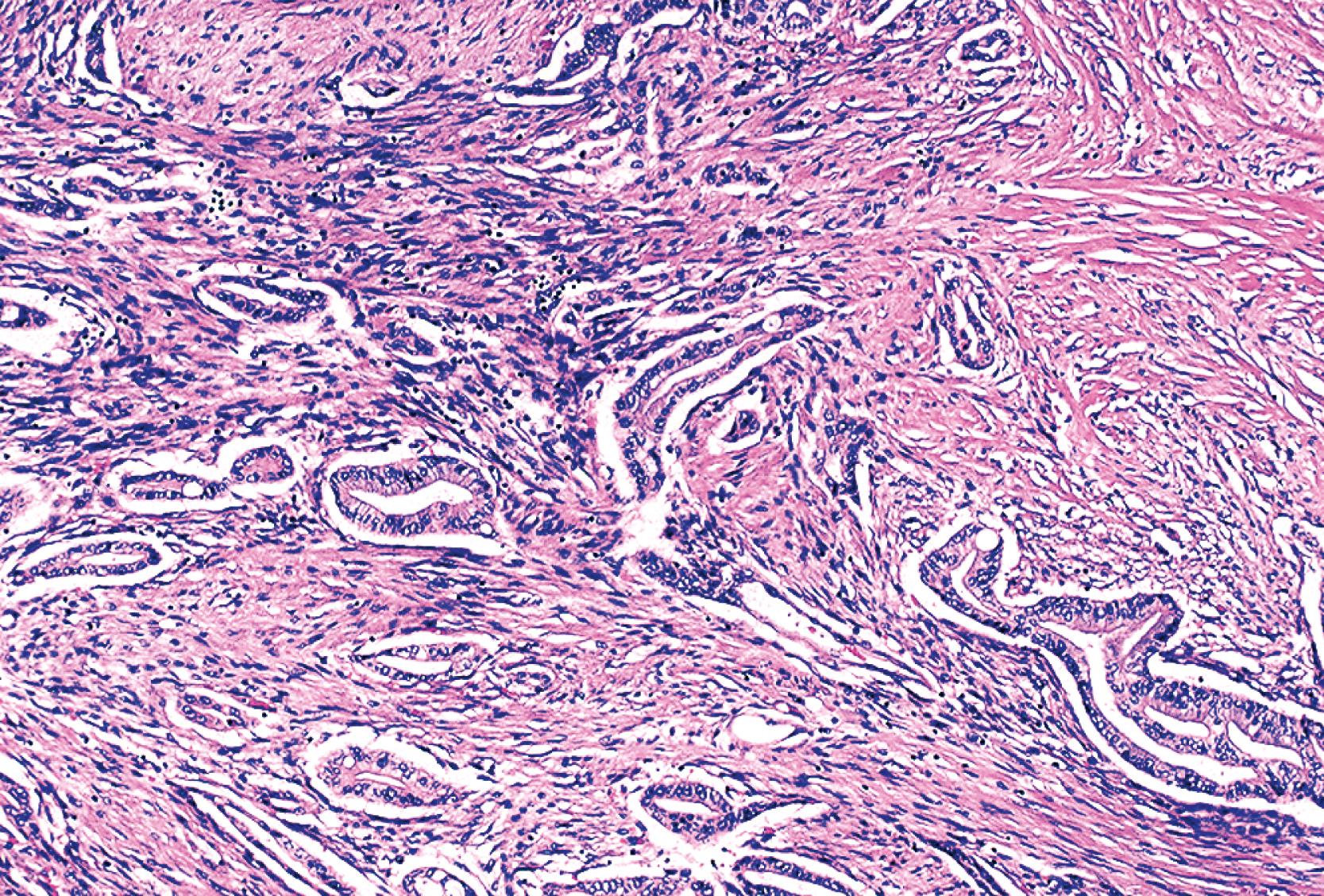
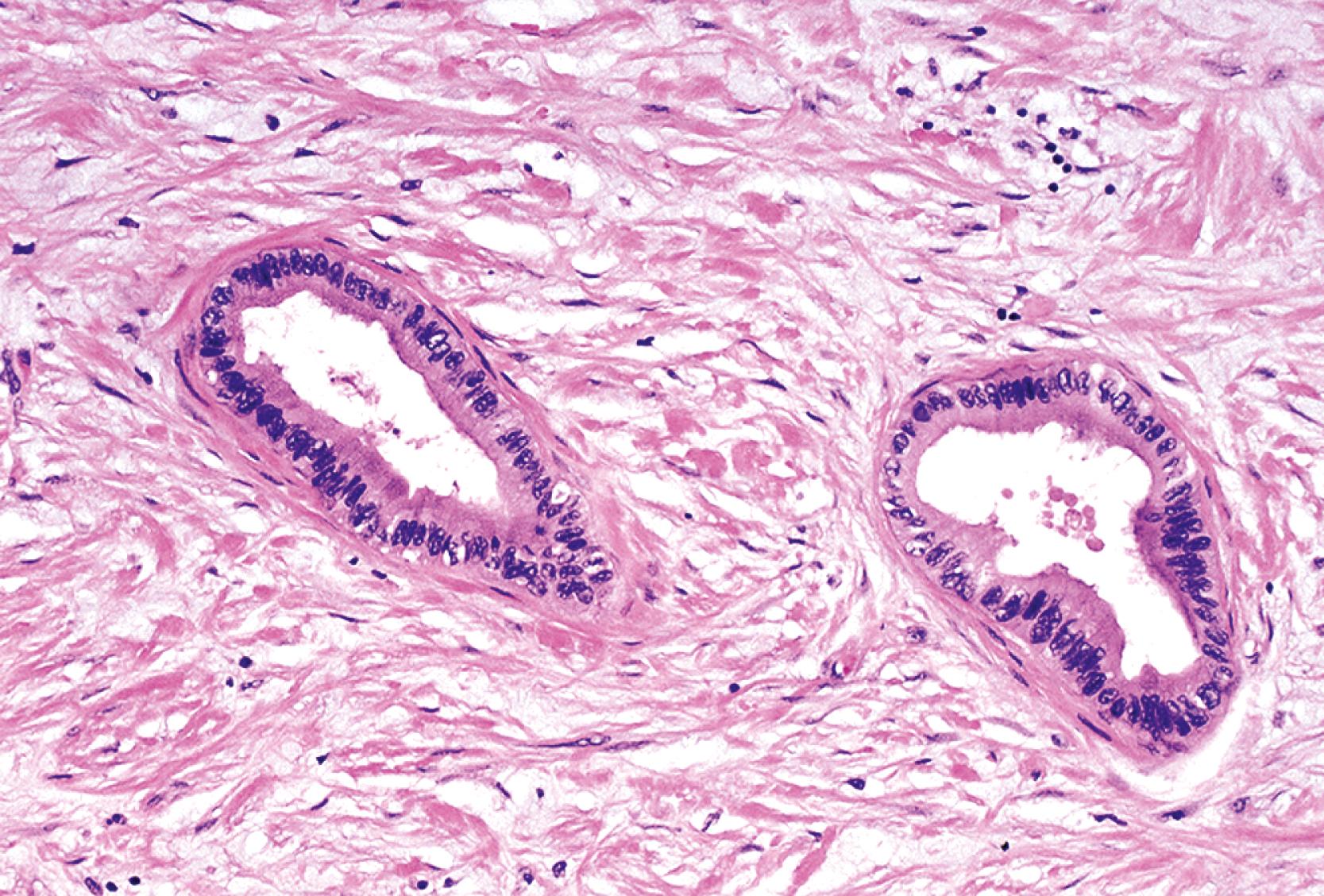
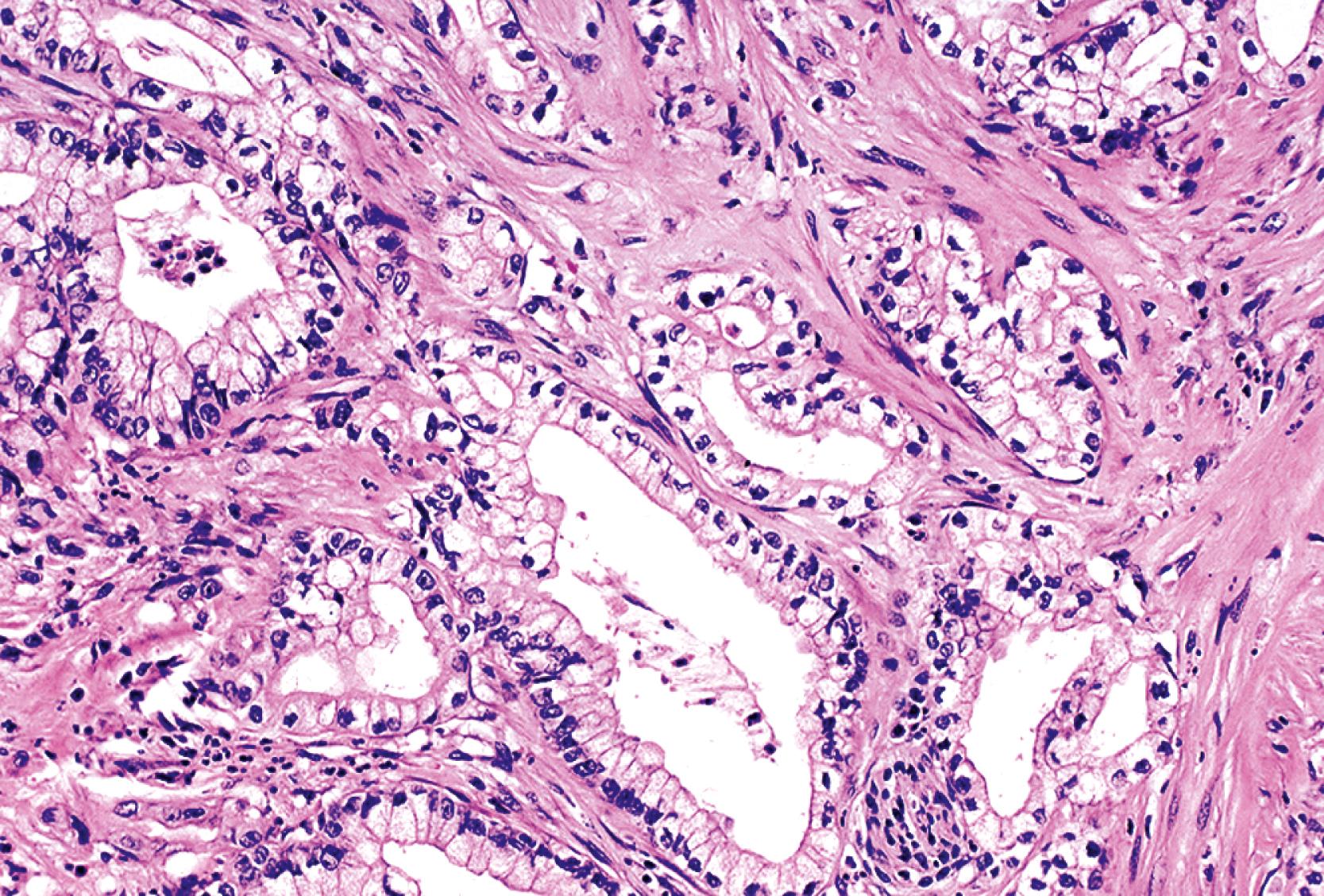
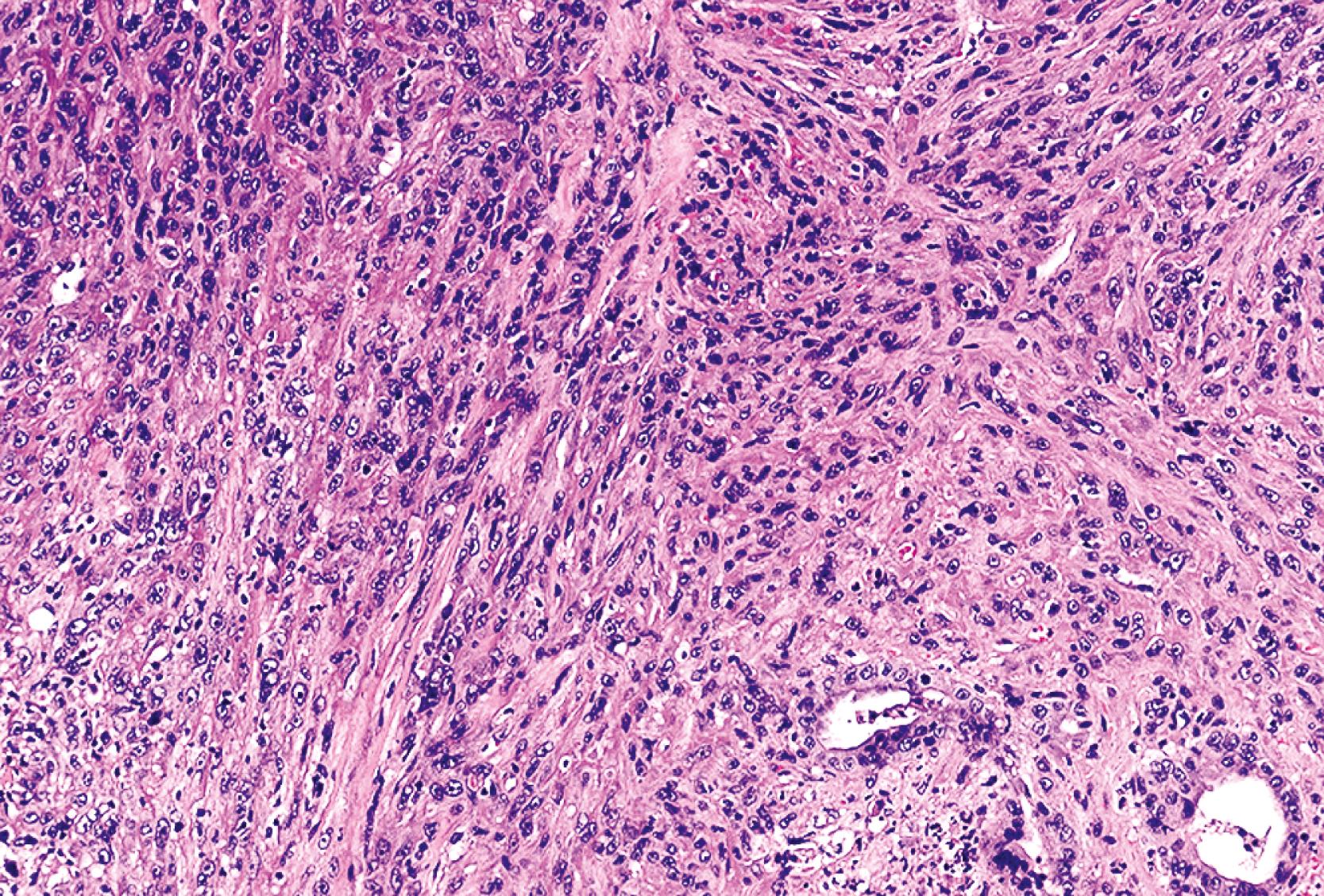
The periphery of ductal adenocarcinomas is often quite indistinct, such that neoplastic glands may be present well beyond the apparent gross extent of the tumor. The finding of isolated glands within otherwise normal peripancreatic adipose tissue, several millimeters from the nearest edge of the carcinoma, confounds the measurement of the tumor and the evaluation of the soft tissue margins. Invasion of preexisting epithelial structures, such as the common bile duct, duodenal mucosa, blood vessels, or native pancreatic ducts, can result in colonization of the basement membrane of the invaded structure, which may simulate a preinvasive neoplasm, such as a duodenal adenoma or pancreatic intraepithelial neoplasia (PanIN). Continuity of intraductal neoplastic cells with frankly invasive elements supports an interpretation of colonization.
The current grading scheme for PDAC (the Kloppel grading scheme, also endorsed by the WHO) entails evaluation of glandular differentiation, mucin production, mitoses, and nuclear atypia. This scheme correlates well with prognosis but is rather cumbersome; hence, it is not widely used. Another proposal advocates assigning two scores to the most prevalent and second most prevalent patterns, mirroring Gleason grading for prostate carcinoma; this system is more independently significant in predicting outcome but is also not in common use. In fact, most pathologists grade PDAC based simply on the extent of gland formation, mirroring the grading of colorectal adenocarcinoma. The American Joint Committee on Cancer (AJCC) staging parameters for ductal adenocarcinoma are available in the AJCC staging manual.
Chronic pancreatitis (interstitial fibrosis, atrophy, and modestly dense inflammation) is often present in the pancreatic tissue adjacent to ductal adenocarcinomas. Distinction of chronic pancreatitis from carcinoma is discussed later (see Differential Diagnosis). In addition, the lining of native pancreatic ducts may show proliferative changes (PanIN, see later). Squamous, transitional, intestinal, and rarely, oncocytic metaplasia may be seen within the nonneoplastic ducts.
Mucin histochemical stains and immunohistochemical markers of ductal differentiation (glycoproteins) invariably show at least focal positivity within conventional ductal adenocarcinomas. In addition, stains for cytokeratins (CKs) 7, 8, 18, and 19 and epithelial membrane antigen (EMA) are usually positive. CK20 is detected in about 25% of cases, and its expression is usually less widespread and intense than that of CK7. The exception to this cytokeratin expression pattern is colloid carcinoma, in which CK20 expression is strong and diffuse (see later discussion). , Immunohistochemical markers of glycoproteins often detectable in ductal adenocarcinoma include CA19-9, CEA, B72.3, CA125, and DUPAN-2. Of these, CEA, B72.3, and CA125 are regarded as tumor-associated glycoproteins that are not significantly expressed in normal ductal cells, and they are expressed only to a limited degree in low-grade PanIN. The MUC proteins are also expressed in different types of ductal neoplasms to varying degrees. Most conventional ductal adenocarcinomas express MUC1, MUC3, MUC4, and MUC5AC. , In contrast, MUC2 is not expressed in ductal adenocarcinomas other than those with intestinal differentiation, such as colloid carcinoma (see later discussion). MUC6, a marker of pyloric gland differentiation, is expressed in 35% of ductal adenocarcinomas. Stains for chromogranin or synaptophysin may demonstrate a minor neuroendocrine cell component associated with the neoplastic glands. Some neuroendocrine cells are nonneoplastic islet cells entrapped within the tumor because ductal adenocarcinomas have a propensity to invade islets. However, neoplastic neuroendocrine cells also occur within ductal adenocarcinomas. ,
The molecular alterations in ductal carcinomas have been studied extensively in past decades. A comprehensive genomic analysis of over 20,000 genes disclosed that most cases have primarily point mutations, which average 63 per tumor. Twelve core signaling pathways were altered in 67% to 100% of the tumors. The most commonly mutated genes include KRAS, p16/CDKN2A, TP53, and SMAD4 . , Mutations in codon 12 of the KRAS oncogene are detected in more than 90% of ductal adenocarcinomas, and TP53 mutation occurs in 50%. Most ductal adenocarcinomas also harbor abnormalities in CDKN2A, through either mutation or hypermethylation of the promotor region of DNA. Loss of SMAD4 (DPC4) is also found in 55% of invasive ductal adenocarcinomas. , There are many other molecular abnormalities in ductal adenocarcinoma, but this previously mentioned constellation of genetic changes is characteristic and distinguishes ductal adenocarcinomas from pancreatic neoplasms of other cell lineages. Other pathways commonly altered include apoptosis, regulation of the G1/S phase transition, hedgehog signaling, DNA damage control, cell adhesion, integrin signaling, JNK signaling, control of invasion, GTPase signaling, transforming growth factor (TGF)-β signaling, and notch signaling. Mutations in mismatch repair genes, BRCA2, STK11/LKB1, BRAF, TGFBR2, and MAP2K4 are less common, but some of these underly the hereditary cases of pancreatic ductal carcinoma. Analysis of gene expression has revealed a number of other overexpressed molecules within ductal adenocarcinomas (e.g., fascin, mesothelin, claudin-4, S100AP, S100A6, and S100P), some of which have been used as potential immunohistochemical markers to help distinguish reactive (nonneoplastic) glands from carcinoma. Strong immunoexpression of p53 , or complete loss of immunoexpression of DPC4, can be used to support a diagnosis of carcinoma, although both of these markers lack a high degree of sensitivity.
The main diagnostic consideration for conventional ductal adenocarcinoma is the distinction of a well-differentiated carcinoma from benign ductules in areas of atrophic chronic pancreatitis. Ductal adenocarcinoma may appear deceptively bland, and ductules in chronic pancreatitis may appear infiltrative. On low-power examination, ductules in areas of chronic pancreatitis retain the original lobular configuration of the normal pancreas because they represent the residual intralobular ductules remaining after the loss of acinar elements during atrophy. Each lobular cluster of ductules contains a central larger, branched, slightly dilated duct surrounded by small round ductules ( Fig. 41.7 ). The stroma within each lobule often is less dense than that between lobules. In contrast, invasive glands lack a lobular growth pattern and are usually distributed more haphazardly (see Fig. 41.7 ). The contours of individual glands are also usually irregular and angulated. Some glands may be incomplete, with epithelium lining only part of the neoplastic lumen and stroma lining the rest. Cytologically, nuclear enlargement, nuclear contour irregularities, and loss of nuclear polarity are important clues to a diagnosis of carcinoma. Variation in size, shape, and intracellular location between adjacent nuclei within individual glands indicates malignancy. The finding of a nuclear volume variation of 4:1 is considered highly suspicious for carcinoma. Dense acidophilic cytoplasm is more common in carcinoma compared with benign conditions. Unlike other sites where reactive stromal cells may display significant atypia, pleomorphism and bizarre nuclei are uncommon in the stroma of inflammatory conditions of the pancreas. Thus individual atypical cells within the stroma of the pancreas are much more likely to be cancer cells, especially if they contain dense acidophilic cytoplasm. The finding of atypical glands in abnormal locations is also helpful. For instance, perineural or vascular invasion, invasion of the duodenal muscularis propria, invasion of stroma closely adjacent to a muscular vessel, , and immediate juxtaposition of duct to adipocytes are all features considered nearly 100% diagnostic of carcinoma ( Fig. 41.8 ). Familiarity with the morphological spectrum of ductal adenocarcinomas including those of the variants such as foamy gland, large duct, and vacuolated (see the Morphological Patterns of Ductal Adenocarcinoma section) may also aid in this differential.
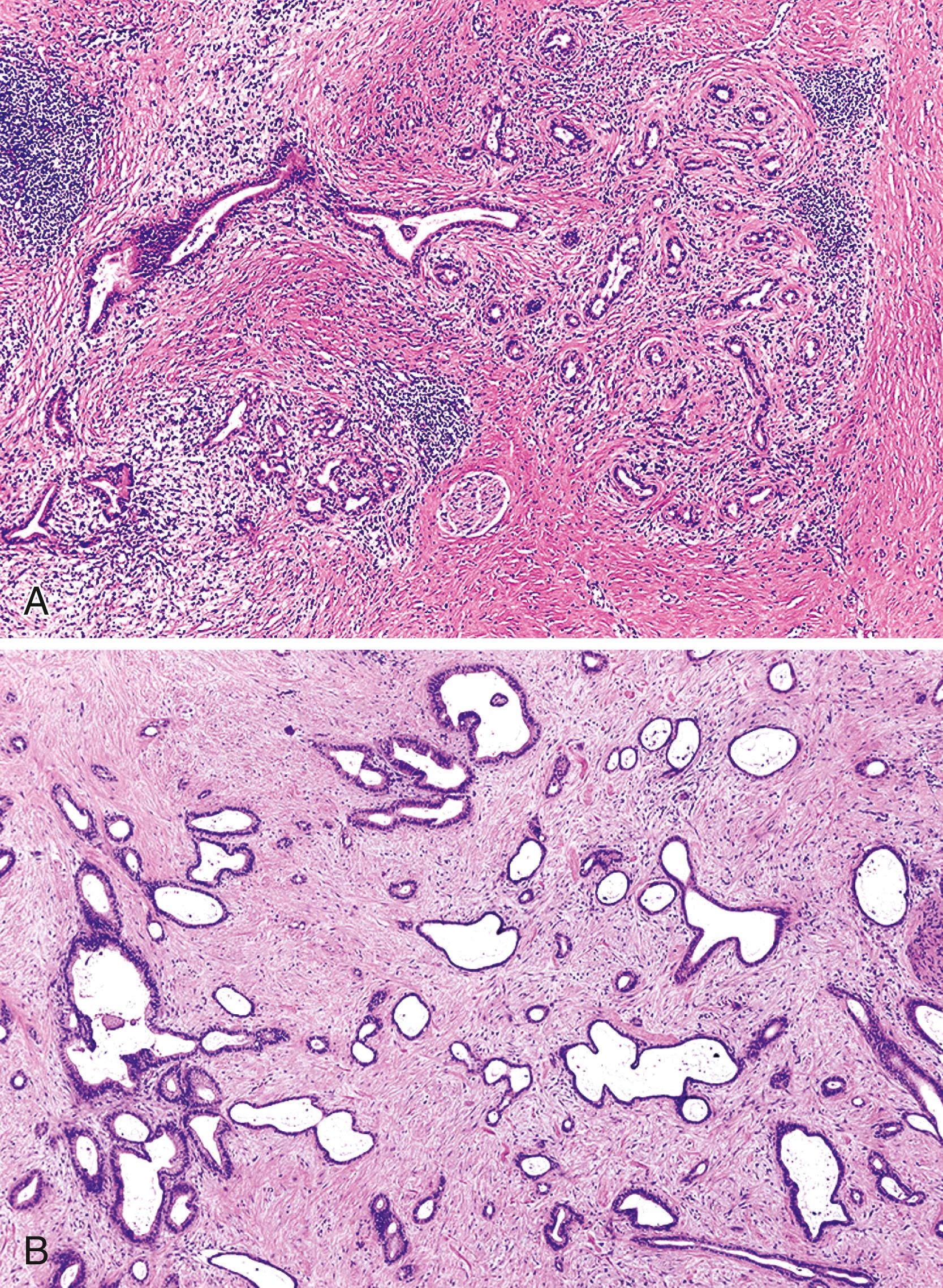
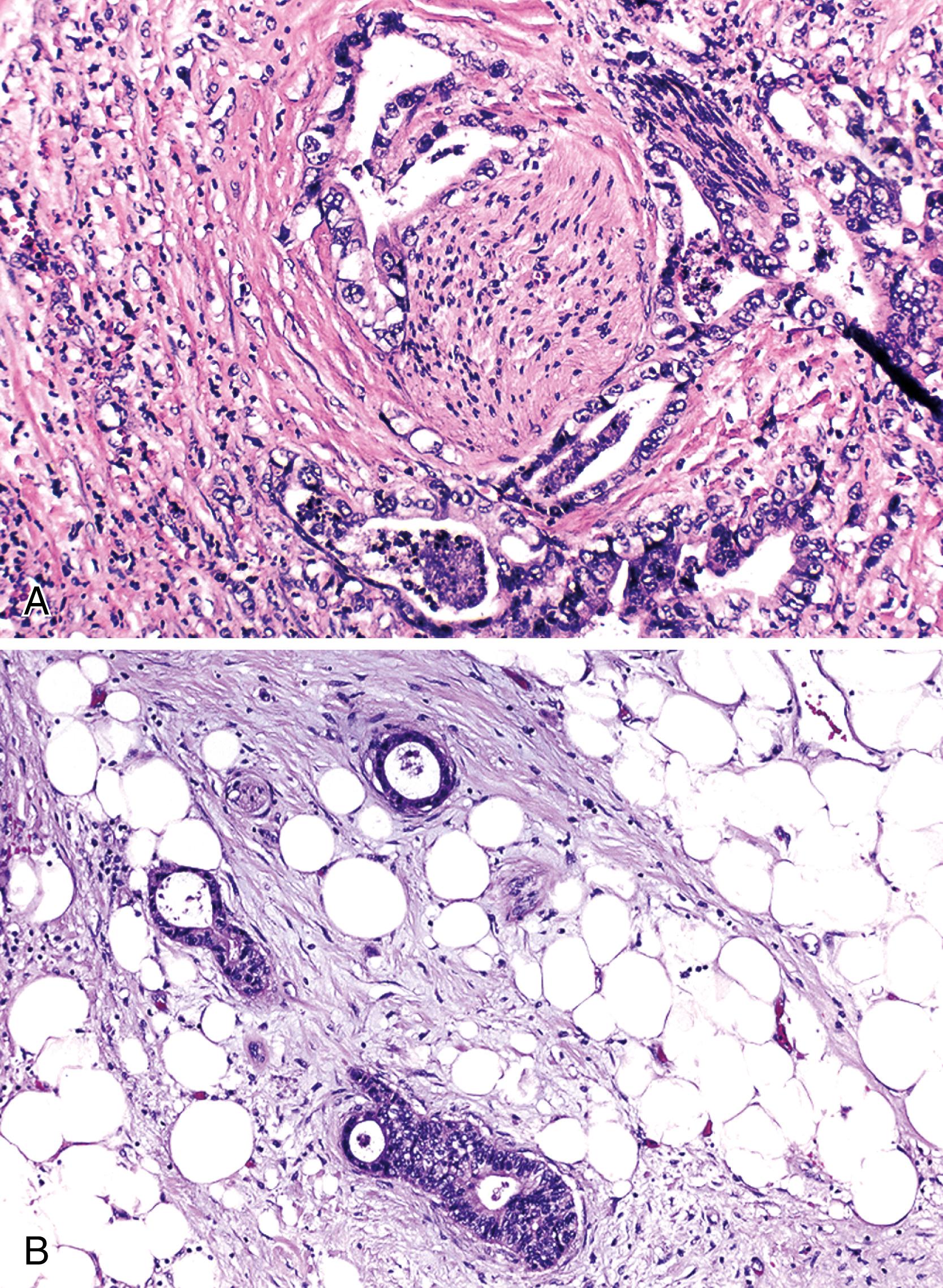
Invasive ductal adenocarcinoma should also be differentiated from noninvasive PanIN (see later), which can be challenging because high-grade PanIN displays most of the cytological abnormalities of invasive carcinoma. Evaluation of the number, distribution, and location of the individual glandular units (in relation to the lobular architecture) is helpful in this pathological distinction. Furthermore, the presence of desmoplastic stroma and irregularity of ductal contours are features of invasive carcinoma. Pancreatic ducts do not contain a basal or myoepithelial cell layer, and many of the abnormalities of invasive carcinoma are also present in high-grade PanIN; therefore no immunohistochemical stains can reliably determine whether a specific atypical gland is invasive. When the differential diagnosis on a core needle biopsy includes high-grade PanIN and invasive carcinoma, it is worth considering that high-grade PanIN is rarely encountered in the absence of invasive carcinoma somewhere in the gland, especially when there is a pancreatic mass.
Another potential pitfall in the differential diagnosis of ductal adenocarcinoma is aggregation of islets in atrophic chronic pancreatitis ( Fig. 41.9 ). Clustered islets may form small irregular nests or cords of cells that have an infiltrative appearance. Occasionally these islet cells are situated around small nerve fibers, simulating perineural invasion by carcinoma. However, the uniformity of cells, the presence of round nuclei with neuroendocrine-type chromatin, and lack of glandular lumina all help point toward a benign reactive process. Immunolabeling for neuroendocrine markers (chromogranin and synaptophysin) can be helpful in problematic cases.

Adenocarcinomas of other organs can resemble PDAC, especially carcinomas arising in the biliary tree or upper gastrointestinal tract. Metastases to the pancreas from sites such as the lung, breast, or gynecological organs can be confused for pancreatic primary tumors, but more commonly, it is the liver or peritoneal metastasis for which a pancreatic primary tumor is considered, along with multiple other organs. Although the immunophenotype and molecular profile of PDAC mentioned earlier is characteristic, it is not sufficiently specific to be useful in the distinction from adenocarcinomas of other sites. Coexpression of CK7, CK19, CEA, CA19-9, B72.3, and CA125 can occur among multiple primary adenocarcinomas, and the lack of expression of lung markers (TTF1, Napsin-A) or hormone receptors does not exclude origin in the lung, breast, or gynecological tract. It should be noted here that the differential diagnosis of adenosquamous carcinoma as a primary versus secondary tumor could be the most problematic, and adenosquamous carcinoma originating from the lung may lack TTF1. Clinical and radiographic correlation is often needed to define the primary site in these cases. In the distinction between metastatic pancreatic carcinoma and primary cholangiocarcinoma, in situ hybridization for albumin may be helpful because the small duct (peripheral) type of cholangiocarcinoma is positive, and pancreatic carcinomas are negative.
As mentioned earlier, the prognosis of patients with PDAC is dismal. The overall 5-year survival rate is about 10%. Its biological properties including its ability for insidious spread, common neural involvement, and vascular involvement early on are all believed to play a role in its highly aggressive behavior. A major contributor to the poor prognosis is the advanced stage at presentation for most patients: 49.6% of cases of newly diagnosed pancreatic carcinomas present with distant metastases, 29.1% present with regional lymph node involvement, and only 10.8% have tumors that are localized solely within the pancreas (Surveillance Epidemiology and End Results (SEER)-21, 2008–2017). Survival rates are stage-dependent: 39.4% for localized disease, 13.3% for regional metastases, and 2.9% for metastatic disease (SEER-18, 2010–2016). Surgical resection is considered the best hope for long-term survival. However, only about 30% of ductal adenocarcinomas are resectable at the time of diagnosis. In addition to high-resolution CT scanning, laparoscopy is used to identify radiographically occult metastatic disease before laparotomy. Over time, the proportion of patients with very-early-stage pancreatic carcinoma (stage IA and IB) has increased, and the survival of these patients has improved. The 5-year survival for stage IA (node-negative, measuring less than 2 cm) is in excess of 80%. Note, however, that the survival for other resectable stages of disease (stage IIA and IIB) has improved only marginally, emphasizing the need to diagnose pancreatic carcinoma very early; only 1.8% of the patients in this SEER analysis were diagnosed at stage I. Survival beyond 7 to 8 years is exceedingly uncommon, and patients may still die of their pancreatic carcinoma after 5 years. Some authors advocate adjuvant therapy (chemotherapy and radiation) after surgery, and neoadjuvant treatment is increasingly used before surgery. Cases that are unresectable are usually treated with chemotherapy. Current chemotherapy protocols include mainly gemcitabine or 5-FU, often in combination with other agents.
Ductal adenocarcinoma of the pancreas includes, in addition to its conventional tubular pattern, several morphological variations. The clinical and biological characteristics of these patterns do not differ significantly from those of conventional ductal adenocarcinoma, but the morphological features are distinctive and may raise differential diagnostic issues. These patterns are often found focally within otherwise typical ductal adenocarcinomas.
This pattern represents a subtle, well-differentiated carcinoma that mimics benign glands with low-grade PanIN. This variant is characterized by infiltrating, well-formed glands lined by fairly well polarized columnar cells that contain abundant, pale microvesicular cytoplasm. The nuclei are typically confined to the base but wrinkled in appearance, with indentations caused by the cytoplasmic contents ( Fig. 41.10 ). The most characteristic features that help distinguish this variant from low-grade PanIN are the presence of foamy, microvesicular, pale cytoplasm with vesicles that are small, fine, and evenly sized, and apical chromophilic condensation of the cytoplasm that forms a thin, well-delineated band reminiscent of a brush border. Although the apical condensation is strongly positive with mucin markers, the microvesicular component of the cytoplasm is typically negative (in contrast with ducts involved by PanIN that are often PAS positive). p53 is also often abnormally expressed in the nuclei of these malignant glands.

Occasionally, invasive tubular adenocarcinomas show a microcystic appearance because of ectasia of infiltrating neoplastic glands ( Fig. 41.11 ). For unclear reasons, this phenomenon may be particularly pronounced in regions of the tumor infiltrating the muscularis propria of the duodenum. Although microcystic glands may be detected grossly, cystic change is generally not pronounced enough to be detected radiographically as a “cystic mass.” The cytological appearance of the epithelium may be deceptively bland. They also often have a cribriform pattern and papilla or micropapilla formation that creates a picture indistinguishable from IPMN or PanIN, especially if a given duct is examined out of context. Patients with tumors that contain a large duct pattern have only a slightly longer survival rate compared with patients who have conventional ductal adenocarcinoma. Thus it is important to distinguish cystic dilation of an invasive gland from a noninvasive component of an MCN or intraductal neoplasm, both of which have a much more favorable prognosis. Features that favor large duct–type adenocarcinoma are the presence of clustering of glands, haphazard distribution, angulations and irregularity of the contour of the ducts, and the presence of a desmoplastic stroma. Tumor cells also often contain intraluminal necrotic debris with neutrophils.

This pattern reveals a gland-in-gland architecture in which tumor cells form cribriformed nests punctuated by multiple large vacuoles (or microcysts) that contain cellular debris and mucin ( Fig. 41.12 ). These vacuoles apparently form by the merging of multiple intracytoplasmic lumina that punctate a nest or cluster of cells. This is different than the cribriform pattern displayed by colonic adenocarcinomas, which typically have polarization of cells that create glands and rosettes. Focally, vacuolated cells have the morphological features of adipocytes or signet ring cells. This pattern may be helpful in the differential diagnosis of metastatic tumors of unknown origin because it is seen only rarely in other types of adenocarcinoma.

Occasionally, ductal adenocarcinoma may display a focal pattern of growth similar to that of mammary lobular carcinoma. , Instead of forming tubules, the tumor cells form cords and may have an “Indian-file” appearance ( Fig. 41.13 ). Targetoid patterns, as well as individual cell infiltration, may also be present, often with signet ring cell formation. This growth pattern may remotely mimic diffuse-type gastric adenocarcinoma and is often associated with conventional tubular-type ductal adenocarcinoma elsewhere in the tumor. However, it is almost never of the type that is seen in true poorly cohesive cell carcinomas. In fact, a true signet ring carcinoma or poorly cohesive cell carcinoma occurring in this region should be considered secondary from either ampulla or stomach before it can be classified as a pancreatic primary tumor.

Poorly differentiated PDACs may infiltrate in a nested pattern without prominent gland formation, mimicking a neuroendocrine neoplasm or squamous cell carcinoma ( Fig. 41.14 ). However, most of these cases contain foci of conventional ductal adenocarcinoma. In some cases, the cells display abundant acidophilic cytoplasm and single prominent nucleoli. This creates a picture reminiscent of a hepatocellular carcinoma (hepatoid pattern) or an oncocytic neoplasm. , However, the immunohistochemical staining pattern is different from hepatocellular carcinoma. In some cases, cells with a nested pattern show clear cytoplasm, resembling renal cell carcinoma. Some authors refer to this variant as clear cell carcinoma. , In a recent study, these solid-nested growth patterns were found to be a part of the centrally necrotic/hyalinizing carcinomas, akin to those in the breast. ,

Some poorly differentiated ductal adenocarcinomas exhibit a micropapillary pattern, with solid clusters of cells suspended in lacunar spaces ( Fig. 41.15 ). The micropapillary pattern is generally a focal finding within an otherwise conventional ductal adenocarcinoma, but it can be extensive. Infiltration of neutrophils in regions with the micropapillary pattern has been noted. As in other anatomic locations, pancreatic carcinomas with a micropapillary pattern are particularly aggressive.

Colloid carcinoma is a clinically and biologically distinct type of pancreatic adenocarcinoma of ductal lineage, but it has to be viewed differently than ordinary ductal adenocarcinomas. Whereas the tumor types discussed earlier are clinically aggressive, colloid carcinomas have a more indolent clinical course. Colloid carcinoma, previously referred to as mucinous noncystic carcinoma, is characterized by stromal pools of mucin containing scant malignant epithelial cells arranged as strips, stellate or cribriform clusters, small tubules, or individual signet ring cells ( Fig. 41.16 ). Colloid carcinomas are usually associated with an intraductal papillary mucinous neoplasm of intestinal type. Colloid carcinomas have a more favorable clinical course than invasive carcinomas of conventional ductal type. The 5-year survival rate is 55%, compared with 12% to 15% for conventional ductal adenocarcinomas. , Some patients died of thromboembolic complications. In one study, all patients who died had a history of an incisional biopsy, which raises the possibility that disruption of the integrity of the tumor may cause dissemination of these highly mucinous lesions. Colloid carcinomas share intestinal differentiation (expression of CK20, MUC2, and CDX2) with IPMNs of intestinal types. Although these tumors harbor similar molecular abnormalities as conventional ductal adenocarcinoma (mutations in KRAS and TP53 ), they are less frequent in colloid carcinomas. Furthermore, loss of DPC4 essentially never occurs in colloid carcinomas. ,

Similar to medullary carcinomas in the breast and large intestine, medullary carcinoma of the pancreas is defined as having broad sheets of poorly differentiated cells with a syncytial pattern of growth. They are much more common in the ampulla. In fact, before a case of medullary carcinoma can be classified as primary, the possibility of an ampullary origin must be ruled out with thorough evaluation. Of note, the differences in the frequency of microsatellite instability (and PDL1) reported for “pancreatic” cancers may partly be attributed to the inclusion of ampullary cancers as pancreatic. As described in other organs, the periphery has pushing borders, and the tumor is mostly devoid of a desmoplastic reaction but can exhibit tumor-infiltrating lymphocytes ( Fig. 41.17 ). , Experience with these tumors is limited. Their natural history and prognosis are poorly understood, but they do not appear to be significantly different from conventional ductal adenocarcinomas. In contrast with conventional ductal adenocarcinoma, some medullary carcinomas are associated with genetic alterations commonly seen in medullary carcinomas of the colon (microsatellite instability), and the rate of KRAS mutations is low. Some patients have a personal or family history of colon cancer, which raises the possibility of an associated inherited cancer syndrome.

Become a Clinical Tree membership for Full access and enjoy Unlimited articles
If you are a member. Log in here